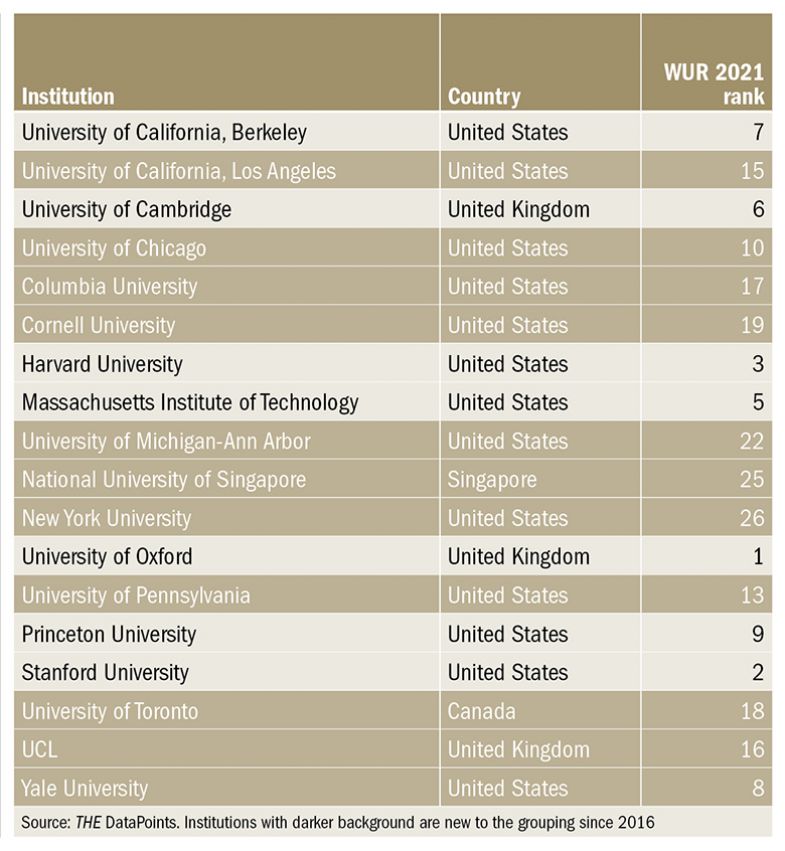It can be easy to assume that the hierarchy of global higher education institutions remains the same over time, particularly at the top of the ladder, and that universities’ missions and subject focus stay relatively stable.
But a new analysis of Times Higher Education data reveals how the landscape has changed since 2015, demonstrating that several leading universities have sought to become more comprehensive and build their prestige across a broader range of subjects, while an increasing number of “middle tier” institutions are focusing on engineering and innovation in a bid to drive up their performance.
The research, conducted by THE’s data team, grouped universities that feature in the THE World University Rankings using a clustering model, based on their research influence, and the perception of their performance across different subjects. The clusters are updated each year based on the latest rankings data.
When the analysis was first conducted, based on the 2016 World University Rankings, just seven universities in the UK and the US featured in the most elite group, named the “old stars”, which achieve a strong research performance and a high level of global prestige across all major subject areas but tend to particularly outperform other institutions in the arts. Now 18 universities, including institutions in Canada and Singapore, are in this cluster.
The 11 new entrants previously excelled in a smaller number of subjects, often in clinical disciplines, and their research influence had outweighed their prestige.
Another notable trend is a significant increase in the number of “technology challenger” universities – those focused on physical sciences and engineering, with strong industry links but without the research performance of their more prestigious peers. The number of institutions in this group, many of which are in Europe and Asia, has almost doubled, from 48 to 94, since 2015.
“Old stars”: Top institutions in research performance and prestige

Bjørn Stensaker, director of the Center for Learning, Innovation and Academic Development at the University of Oslo and an expert on the organisation and management of universities, said that one possible explanation for the increase in the number of top-performing comprehensive institutions was the “strategic ‘catch-up’ perspective, where those institutions that are seen as leaders inspire others to follow suit”.
The increasing mobility of academic staff and a more globally oriented academic workforce was another potential factor, he added, especially given the theory that globalisation results in more similar universities across the world.
But Professor Stensaker said a key factor related to the resources and capacity of institutions to become “world class”.
“I think it is interesting that many of these universities are found in urban settings – London, Singapore, New York – where the location provides added value, so to speak, economically, culturally and socially,” he said.
“There are many universities that want to become elite institutions – the problem is that they do not have the resources and capacity to realise the ambition.”
Meanwhile, the rising influence of the United Nations’ Sustainable Development Goals on universities and the way in which “notions of academic excellence increasingly are linked to solving global challenges” could be accelerating the trend, according to Professor Stensaker.
“Tackling these challenges requires an interdisciplinary orientation and points to a need for comprehensive universities, but perhaps even more for new forms of collaboration between universities to establish the capacity needed to respond to them,” he said.
“I think the European Universities Initiative is one step in this direction, and when looking globally, I do think we will see a further growth in university alliances, which potentially can lead to a more stratified global higher education sector.”
Tatiana Fumasoli, associate professor in higher education studies at the UCL Institute of Education and an expert on the strategic management of universities, said that higher education institutions (HEIs) “tend to pursue an idealised model of university that is comprehensive and performing well across all disciplines”.
“HEIs that have the resources and organisational capacity will aim at this,” she said, adding that she expected this group would grow and include Chinese universities in the future.
The old stars cluster, which still predominantly consists of US and UK universities, also reflects the higher education strategies of different countries, Dr Fumasoli suggested. The Netherlands has pursued a policy of developing a large number of high-level universities rather than a small number of stand-out institutions and is absent from the group, while the US and UK systems are focused on “several universities competing against each other and, those who can, playing a role globally”.
Dr Fumasoli added that while some institutions such as the universities of Oxford and Cambridge were fixed in “the centre of the global higher education field”, at the boundaries “there can be more movement in and out of the global arena”, so the old stars group may continue to change over time.
Meanwhile, she said that the growth of technology-focused institutions could be related to government policy, student demand and the fact that engineering is a field that is often involved in interdisciplinary research projects with high levels of societal impact. This means that it can attract research funding more quickly than many other fields, she said.
Professor Stensaker agreed that government policies and funding have played a central role in the establishment of engineering-focused universities.
“If we look at where the large sums of money are found, it is within the STEM field, and this is also the area where industry also is mostly looking for cooperation,” he said.
Find out more about THE DataPoints
THE DataPoints is designed with the forward-looking and growth-minded institution in view
POSTSCRIPT:
Print headline: Academia’s top echelon expands with new ‘stars’
Register to continue
Why register?
- Registration is free and only takes a moment
- Once registered, you can read 3 articles a month
- Sign up for our newsletter
Subscribe
Or subscribe for unlimited access to:
- Unlimited access to news, views, insights & reviews
- Digital editions
- Digital access to THE’s university and college rankings analysis
Already registered or a current subscriber? Login








